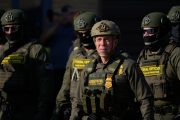According to Pentagon data cited by The Daily, the Defense Department gave away almost $500 million worth of surplus military equipment to state and local law enforcement in 2011 — a new record. And next year’s orders are already up more than 400 percent.
Meanwhile, violent crime has plummeted to 40-year lows. But since the 1033 program was authorized by Congress in 1997, more than $2.5 billion of gear has been distributed to over 17,000 local and state agencies.
“The trend toward militarization was well under way before 9/11,” Tim Lynch, director of the Cato Institute's project on criminal justice, told The Daily. “But it’s the federal policy of making surplus military equipment available almost for free that has poured fuel on this fire.”
Lynch said the militarization of local law enforcement has had a “corrupting influence” on policing culture in America, creating “paramilitary” units all across the nation. “They say, ‘look we’ve got this equipment, this training and we haven’t been using it.’ That’s where it starts to creep into routine policing,” he added.
The Daily, a relatively new media organization making use of emerging technologies, interviewed several current and former law-enforcement chiefs for the story. Opinion varies widely and some police support the idea. For others, however, it is a sinister and troubling trend.
“The profile of these military police units invading a neighborhood like the occupation army is contrary to what you want to do as a police department,” explained former Kansas City, Missouri, police chief Joseph McNamara, calling it contrary to good policing. It is also risky and counterproductive, he said.
“The idea that some police have that by being really super tough and military and carrying military weapons is a way to prevent crime — this is false,” concluded McNamara, who served as the chief of police for the city of San Jose, California, as well. “We have a lot of evidence on how to prevent crime and the major component is to win support for police, that we’re not this aloof occupation army.”
While concerns about the militarization of law enforcement have been expressed for years by the Left and Right, The Daily article published on December 5 has been picked up around the world. Even media in Iran and Russia used it to paint America as a full-blown police state.
“Battlefield US: Pentagon arms police departments with free heavy weaponry,” blared a headline in RT, a Russian media outlet. Iran’s PressTV titled its article on the subject “US equips police with military weapons.”
Two days before The Daily’s article by Benjamin Carlson appeared and drew worldwide attention to the issue, the New York Times also examined militarization of law-enforcement, but from more of a mindset perspective. The Times’ piece and other analysts have noted that the roles of law enforcement and the military are completely different. Taxpayers hire police officers to protect and serve their local communities — essentially to keep the peace. They hire soldiers, on the other hand, to smash, kill, and destroy an enemy with overwhelming force.
“Yet lately images from Occupy protests streamed on the Internet — often in real time — show just how readily police officers can adopt military-style tactics and equipment, and come off more like soldiers as they face down citizens,” noted Al Baker in a December 3 piece headlined “When the Police Go Military” for the Times. “Some say this adds up to the emergence of a new, more militaristic breed of civilian police officer.”
The development of militarized police is attributed largely to the federal government by analysts. Americans’ tax dollars are unconsitutionally routed through D.C. only to be returned as “grants” with strings attached, often to fight various “wars” — terror and drugs most prominent among them -— declared by federal authorities. And the process has served to significantly weaken local citizens’ control over their law-enforcement agencies.
“There is behind this, also, I think, a kind of status competition or imitation, that there is positive status in having a sort of ‘big department muscle,’ in smaller departments,” said University of California law Professor Franklin Zimring. “And then the problem is, if you have those kinds of specialized units, that you hunt for appropriate settings to use them and, in some of the smaller police departments, notions of the appropriate settings to use them are questionable.”
And the problems are only increasing. A 2006 study by the Cato Institute called “Overkill: The Rise of Paramilitary Police Raids in America” examined the ever-increasing number of military-style raids across the country — around 50,000 per year according to some estimates — that end in needless tragedy.
“Over the last 25 years, America has seen a disturbing militarization of its civilian law enforcement, along with a dramatic and unsettling rise in the use of paramilitary police units (most commonly called Special Weapons and Tactics, or SWAT) for routine police work,” the executive summary explained, noting that the “SWAT” raids often inflict unnecessary terror on non-violent drug offenders, bystanders, and even wrongly targeted civilians.
“The raids terrorize innocents when police mistakenly target the wrong residence. And they have resulted in dozens of needless deaths and injuries, not only of drug offenders, but also of police officers, children, bystanders, and innocent suspects,” the paper explained, detailing numerous accounts of abuses and botched operations that left innocent people dead. But record billions worth of military equipment are still being handed to local police.
Meanwhile, as commentators on the subject have pointed out in recent days, the U.S. Senate just voted for a bill that purports to make America into a “battlefield” as part of the global terror war. American citizens deemed by government bureaucrats to represent a “threat” to the “Homeland” under the legislation could be picked up by the military and detained indefinitely — no charges, no jury, no trial.
Photo of members of the Oregon State Police SWAT team: AP Images
Related articles:
Is Law Enforcement Becoming Militarized?
Gun Control Leads to Militarized Law Enforcement
Militarization of Swine Flu Preparations
The Bipartisan War on American Freedom
Police Brutality, Mass Arrests Draw Attention to “Occupy Wall Street”
WikiLeaks Exposing “Mass Surveillance Industry”
Homeland Security-linked CELL Terrorizes Americans
Senate Bill to OK Indefinite Detention of U.S. Citizens Without Charge, Trial




